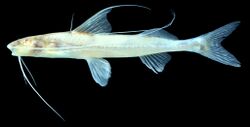Biology:Mastiglanis asopos
| Mastiglanis asopos | |
|---|---|

| |
| Scientific classification | |
| Domain: | Eukaryota |
| Kingdom: | Animalia |
| Phylum: | Chordata |
| Class: | Actinopterygii |
| Order: | Siluriformes |
| Family: | Heptapteridae |
| Genus: | Mastiglanis Bockmann, 1994 |
| Species: | M. asopos
|
| Binomial name | |
| Mastiglanis asopos Bockmann, 1994
| |
Mastiglanis asopos is a species of three-barbeled catfish. It is the only recognized species in its genus.
This species has a broad distribution, mainly throughout the left side tributaries of the Amazon basin and the Capim River basin in Brazil , as well as in the right tributaries of the Amazon basin in Brazil, Orinoco basin of Venezuela, and drainages in Guyana.[1]
M. asopos is a strictly sand-dwelling species. It spends the daytime buried in the top layer of sand.[1] It forages mostly at night and sometimes in the morning. As an ambush predator, when foraging, it poises in the streamlet channel where water is flowing, supported by a tripod formed by its pelvic and anal fins, spreading both its very long barbels and the filamentous dorsal and pectoral-fin rays, thus forming a kind of "drift-trap". When the fish intercepts food, it will lunge at these food particles; after lunging for a short distance, it will return to its previous hunting spot. This behavior is similar to that seen in the tripod fish.[1] Small trichopteran larvae (ingested with the sand cases) and ephemeropterans constituted a considerable portion of the gut contents in a study of Mastiglanis asopos, but their foraging behavior allows a varied diet which includes large chironomid larvae and small adult beetles that would not be consumed by other sand-dwelling animals.[1]
M. asopos grows to 6.6 centimetres (2.6 in) SL.[2] This fish has long barbels and long first pectoral fin rays which are used for feeding. It also has an acuminate (tapered to a point) snout.[1]
References
- ↑ 1.0 1.1 1.2 1.3 1.4 Zuanon, Jansen; Bockmann, Flávio A.; Sazima, Ivan (2006). "A remarkable sand-dwelling fish assemblage from central Amazonia, with comments on the evolution of psammophily in South American freshwater fishes". Neotropical Ichthyology 4 (1): 107–118. doi:10.1590/s1679-62252006000100012.
- ↑ Froese, Rainer and Pauly, Daniel, eds. (2011). "Mastiglanis asopos" in FishBase. December 2011 version.
Wikidata ☰ Q3758949 entry
 |

